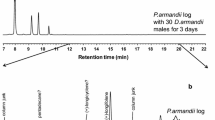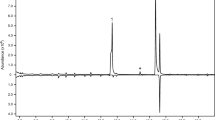Abstract
Ips cembrae adults were collected from larch log piles in northeast China, separated into six attack phases, and immediately frozen in liquid nitrogen. Three previously described aggregation pheromone components [ipsenol, ipsdienol, and 3-methyl-3-buten-1-ol (331-MB)] and six other volatiles of beetle origin (2-phenylethanol, geraniol, ipsenone, ipsdienone, myrtenol and verbenone) were identified and quantified by GC-MS from excised male hindguts. No amitinol, a recently reported aggregation pheromone component, was detected in our samples. The amounts of these volatiles (except the last two) showed a similar pattern of variation between attack phases in males. The largest amounts of most male volatiles were present in phases 1–2, when the nuptial chamber was being constructed or only one female was accepted. The amounts of the volatiles declined sharply in the following phases. The hindgut volatiles, mainly the pheromone components, from 46 individual males in phase 1 were also quantified. Ipsenol, ipsdienol, and 331-MB showed a large variation in both amounts and proportions. The chirality of these two dominant aggregation pheromone components was determined as 100% (−)-enantiomer of ipsenol and 96% (+) enantiomer of ipsdienol. No male aggregation pheromone components were detected from mated females, except three extracts that were probably contaminated by male tissues.
Similar content being viewed by others
REFERENCES
Anderbrant, O., and Schlyter, F. 1989. Causes and effects of individual quality in bark beetles. Holarct. Ecol. 12:488–493.
Anderbrant, O., Schlyter, F., and Birgersson, G. 1985. Intraspecific competition affecting parents and offspring in the bark beetle Ips typographus. Oikos 45:89–98.
Bakke, A., FrÖyen, P., and SkattebÖl, L. 1977. Field response to a new pheromonal compound isolated from Ips typographus. Naturwissenschaften 64:98.
Birgersson, G., Schlyter, F., LÖfqvist, J., and BergstrÖm, G. 1984. Quantitative variation of pheromone components in the spruce bark beetle Ips typographus from different attack phases. J. Chem. Ecol. 10:1029–1055.
Birgersson, G., Schlyter, F., BergstrÖm, G., and LÖfqvist, J. 1988. Individual variation of pheromone content in the bark beetle Ips typographus. J. Chem. Ecol. 14:1735–1759.
Borden, J. H. 1974. Aggregation pheromones in the Scolytidae, pp. 135–160, in M. C. Birch (ed.). Pheromones. North-Holland Publ. Co., Amsterdam.
Borden, J. H., Hunt, D. W. A., Miller, D. R., and Slessor, K. N. 1986. Orientation of forest Coleoptera: an uncertain outcome of responses by individual beetles to variable stimuli, pp. 97–109, in T. L. Payne, M. C. Birch, and C. E. J. Kennedy (eds.). Mechanisms of Insect Olfaction. Oxford University Press, Oxford.
Bowers, W. W., Gries, G., Borden, J. H., and Pierce, H. D., JR. 1991. 3-Methyl-3-buten-1-ol: An aggregation pheromone of the four-eyed spruce bark beetle, Polygraphus rufipennis (Kirby) (Coleoptera: Scolytidae). J. Chem. Ecol. 17:1989–2002.
Byers, J. A. 1981. Effect of mating on terminating aggregation during host colonization in the bark beetle, Ips paraconfusus. J. Chem. Ecol. 7:1135–1147.
Byers, J. A. 1989. Chemical ecology of bark beetles. Experientia 435:271–283.
Fish, R. H., Browne, L. E., and Bergot, B. J. 1984. Pheromone biosynthetic pathways: Conversion of ipsdienone to (—)-ipsdienol, a mechanism for enantioselective reduction in the male bark beetle Ips paraconfusus. J. Chem. Ecol. 10:1057–1064.
Francke, W., and VitÉ, J. P. 1983. Oxygenated terpenes in pheromone systems of bark beetles. J. Appl. Entomol. 96:146–156.
Francke, W., Bartels, J., Meyer, H., SchrÖder, F., Kohnle, U., Baader, E., and VitÉ J. P. 1995. Semiochemicals from bark beetles: New results, remarks, and reflections. J. Chem. Ecol. 21:1043–1063.
Fu, W.-J., Qi, Y.-T., Qiu, H.-G., Shen, B.-J., and Wu, X.-D. 1988. Study on the aggregation pheromone of Ips subelongatus: Characteristic of aggregation behavior and the extraction of active materials. Contrib. Shanghai Inst. Entomol. 8:61–66.
Giesen, H., Kohnle, U., Vit É, J. P., Pan, M.-L., and Francke, W. 1984. Das Aggregationspheromon des mediterranen Kiefernborkenk¨afers Ips (Orthotomicus) erosus. Z. Angew. Entomol. 98:95–97.
Gries, G., Bowers, W. W., Gries, R., Noble, M., and Borden, J. H. 1990. Pheromone production by the pine engraver Ips pini following flight and starvation. J. Insect. Physiol. 36:819–824.
Hackstein, E., and Vit É, J. P. 1978. Pheromonbiosynthese und Reizkette in der Besiedlung von Fichten durch den Buchdrucker Ips typographus. Mitt. Dtsch. Ges. Allg. Angew. Entomol. 1:185–188.
Hughes, P. R. 1974. Myrcene: A precursor of pheromones in Ips beetles. J. Insect Physiol. 20:1271–1275.
Hunt, D. W. A., Borden, J. H., Pierce, H. D., JR., Slessor, K. N., King, G. G. S., and Csyzewska, E. K. 1986. Sex-specific production of ipsdienol and myrcenol by Dendroctonus ponderosae (Coleoptera: Scolytidae) exposed to myrcene vapors. J. Chem. Ecol. 12:1579–1586.
Ivarsson, P., and Birgersson, G. 1995. Regulation and biosynthesis of pheromone components in the double spined bark beetle Ips duplicatus (Coleoptera: Scolytidae). J. Insect Physiol. 41:843–849.
Ivarsson, P., Schlyter, F., and Birgersson, G. 1993. Demonstration of de novo pheromone biosynthesis in Ips duplicatus (Coleoptera: Scolytidae): Inhibition of ipsdienol and (E)-myrcenol production by compactin. Insect Biochem. Mol. Biol. 23:655–662.
Ivarsson, P., Blomquist, G. J., and Seybold, S. J. 1997. In vitro production of pheromone intermediates ipsdienone and ipsenone by the bark beetles Ips pini Say and I. paraconfusus Lanier (Coleoptera: Scolytidae). Naturwissenschaften 84:454–457.
Ivarsson, P., Tittiger, C., Blomquist, C., Borgerson, C. E., Seybold, S. J., Blomquist, G. J., and H Ögberg, H.-E. 1998. Pheromone precursor synthesis is localized in the metathorax of I. paraconfusus Lanier (Coleoptera: Scolytidae). Naturwissenschaften 85:507–511.
Kohnle, U., Vit É J. P., Erbacher, C., Bartels, J., and Francke, W. 1988. Aggregation response of European engraver beetles of the genus Ips mediated by terpenoid pheromone. Entomol. Exp. Appl. 49:43–53.
Lanne, B. S., Ivarsson, P., Johnsson, P., BergstrÖm, G., and Wassgren, A.-B. 1989. Biosynthesis of 2-methyl-3-buten-2-ol, a pheromone component of Ips typographus (Coleoptera: Scolytidae). Insect Biochem. 19:163–168.
Miller, D. R., Borden, J. H., and Slessor, K. N. 1989. Inter-and intrapopulation variation of the pheromone ipsdienol produced by male pine engravers, Ips pini (say) (Coleoptera: Scolytidae). J. Chem. Ecol. 15:233–247.
Miller, D. R., Borden, J. H., and Slessor, K. N. 1996. Enantiospecific pheromone production and response profiles for populations of pine engraver, Ips pini (say) (Coleoptera: Scolytidae), British Columbia. J. Chem. Ecol. 22:2157–2172.
Postner, M. 1974. Scolytidae, Borkenkäfer. pp. 334–481, in W. Schwenke (ed.). Die Forstschãdlinge Europas. Bd. II. Paul Parey, Hamburg.
Qiu, H.-G., Fu, W.-J., Qi, Y.-T., He, L.-F., and Liang, X.-D. 1988. Study on the aggregation pheromone of Ips subelongatus: The relationship between aggregation pheromone behavior and is host plant tree. Contrib. Shanghai Inst. Entomol. 8:67–72.
Renwick, J. A. A., and Dickens, J. C. 1979. Control of pheromone production in the bark beetle, Ips cembrae. Physiol. Entomol. 4:377–381.
Schlyter, F., and Birgersson, G. 1989. Individual variation in bark beetle and moth pheromones-a comparison and an evolutionary background. Holarct. Ecol. 12:457–465.
Schlyter, F., and Birgersson, G. 1999. Forest beetles. pp. 113–148, in J. Hardie and A. K. Minks (eds.). Pheromones in Non-Lepidopteran Insects Associated with Agricultural Plants. CAB International, Oxford, U.K.
Schlyter, F., and Zhang, Q.-H. 1996. Testing avian polygyny hypothesis in insects: Harem size distribution and female egg gallery spacing in three Ips bark beetles. Oikos 76:57–69.
Seybold, S. J., Quilici, D. R., Tillman, J. A., Vanderwel, D., Wood, D. L., and Blomquist, G. L. 1995. De novo biosynthesis of aggregation pheromone components ipsenol and ipsdienol by the bark beetles Ips paraconfusus Lanier and Ips pini (Say) (Coleoptera: Scolytidae). Proc. Nat. Acad. Sci. U.S.A. 92:8393–8397.
Sokal, R. R., and Rohlf, F. J. 1995. Biometry, The Principles and Practice of Statistics in Biological Research, 3rd ed. W.H. Freeman and Company, New York.
Stoakley, J. T., Bakke, A., Renwick, J. A. A., and VitÉ J. P. 1978. The aggregation pheromone system of the larch bark beetle Ips cembrae Heer. Z. Angew Entomol. 86:174–177.
Svihra, P. 1982. Influence of opposite sex on attraction produced by pioneer sex of four bark beetle species cohabiting pine in the southern United States. J. Chem. Ecol. 8:373–378.
Teale, S. L., Hager, B. J., and Webster, F. X. 1994. Pheromone-based assortative mating in a bark beetle. Anim. Behav. 48:569–578.
Tillman, J. A., Holbrook, G. L., Dallara, P. L., Schal, C., Wood, D. L., Blomquist, G. J., and Seybold, S. J. 1998. Endocrine regulation of de novo aggregation pheromone biosynthesis in the pine engraver, Ips pini (Say) (Coleoptera: Scolytidae). Insect Biochem. Mol. Biol. 28:705–715.
Wood, D. L. 1982. The role of pheromones, kairomones and allomones in the host selection and colonization behavior of bark beetles. Annu. Rev. Entomol. 27:411–446.
Yu, C.-M., and Zhang, Q.-H. 1988. Biological activity and excretion law of aggregation pheromone of larch bark beetle. J. Northeast For. Univ. 16:1–7.
Zhang, Q.-H., and Niemeyer, H. 1992. Morphological characteristics for sexing living adults of Ips cembrae. J. Appl. Entomol. 14:403–409.
Zhang, Q.-H., and Niemeyer, H. 1995. Field response of the larch bark beetle, Ips cembrae, and its predators to different ratios of pheromone baits and addition of host logs. pp. 19–28, in F. P. Hain, S. M. Salom, W. F. Ravlin, T. L. Payne, and K. F. Raffa (eds.). Behavior, Population Dynamics, and Control of Forest Insects. Proceedings of a Joint IUFRO Working Party Conference, February 1994, Ohio State University. OARDC, Wooster.
Zhang, Q.-H., Liu, Z.-F., Sun, Y.-J., and Jiang, H.-C. 1989. Vertical distribution of the larch bark beetle, Ips subelongatus, on the burned trees of larch. J. Northeast For. Univ. 18:14–18.
Zhang, Q.-H., Yu, C.-M., Wu, X.-D., Liang, X.-D., and Sun, B.-R. 1991. The function of aggregation pheromone in breeding and damage actions of Ips subelongatus. J. Liaoning For. Sci. Technol. 2:39–42.
Zhang, Q.-H., Byers, J. A., and Schlyter, F. 1992. Optimal attack density in the larch bark beetle, Ips cembrae (Coleoptera: Scolytidae). J. Appl. Ecol. 29:672–678.
Author information
Authors and Affiliations
Rights and permissions
About this article
Cite this article
Zhang, QH., Birgersson, G., Schlyter, F. et al. Pheromone Components in the Larch Bark Beetle, Ips cembrae, from China: Quantitative Variation among Attack Phases and Individuals. J Chem Ecol 26, 841–858 (2000). https://doi.org/10.1023/A:1005447922939
Issue Date:
DOI: https://doi.org/10.1023/A:1005447922939




